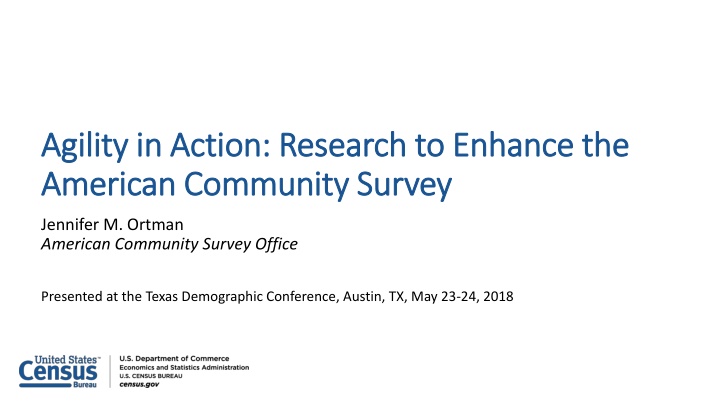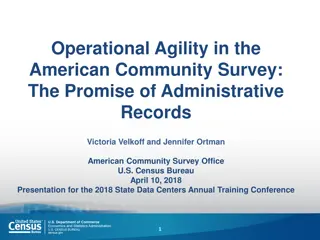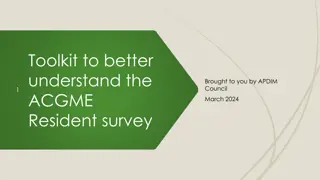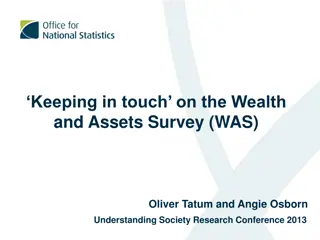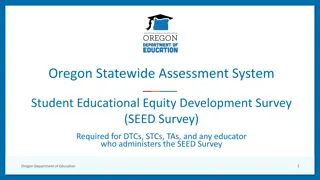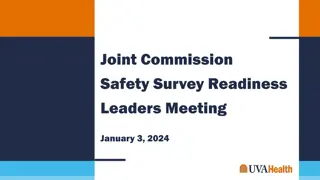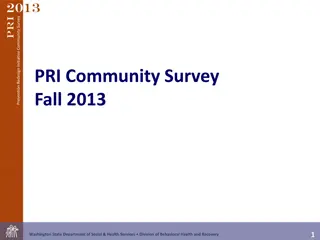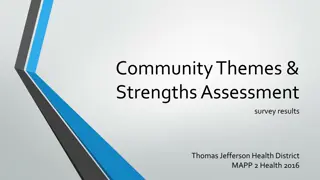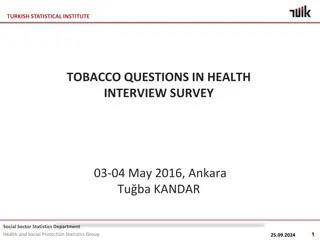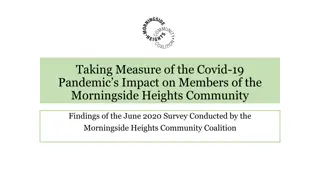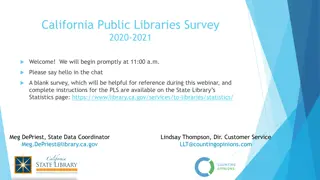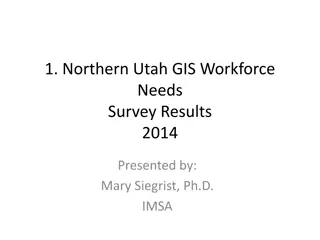Enhancing American Community Survey: Research Insights
Research efforts to enhance the American Community Survey through engagement strategies, alternative data sources, and adaptations to keep up with changing demographics, presented at the Texas Demographic Conference.
Download Presentation

Please find below an Image/Link to download the presentation.
The content on the website is provided AS IS for your information and personal use only. It may not be sold, licensed, or shared on other websites without obtaining consent from the author.If you encounter any issues during the download, it is possible that the publisher has removed the file from their server.
You are allowed to download the files provided on this website for personal or commercial use, subject to the condition that they are used lawfully. All files are the property of their respective owners.
The content on the website is provided AS IS for your information and personal use only. It may not be sold, licensed, or shared on other websites without obtaining consent from the author.
E N D
Presentation Transcript
Agility in Action: Research to Enhance the Agility in Action: Research to Enhance the American Community Survey American Community Survey Jennifer M. Ortman American Community Survey Office Presented at the Texas Demographic Conference, Austin, TX, May 23-24, 2018
Presentation Outline Presentation Outline Overview of the ACS What We Value Turning Our Values into Action Research to Enhance the ACS Engaging Respondents through Mail Materials Understanding the Respondent s Experience Changing the ACS to Keep Up with the Times Employing Alternative Data Sources 2
The American Community Survey The American Community Survey The Basics Ongoing monthly survey sent to 3.5 million addresses per year to produce detailed population and housing estimates each year Visit 20,000 Group Quarter facilities and sample approximately 194,000 residents each year Designed to produce critical information on small areas and small population groups previously collected on the decennial long form Covers 35+ topics and supports over 300 known Federal government uses Used to distribute more than $675 billion federal funds each year Data released annually 1-year estimates (12 months of data) 5-year estimates (60 months of data) 3
The American The American Community Survey Community Survey Decennial Census and the American Community Survey 1790 1800 1810 1820 1830 1840 1850 1860 1870 1880 1890 1900 1910 1920 1930 1940 1950 1960 1970 1980 1990 2000 2010 2020 1790-1930 Census one form to all households 1940-2000 Census short form & long form 1996 1996-2004 ACS demonstration period 2000 2005 2005-present ACS annual estimates for all geographies 2010 2010 Census and future short form only 2020 4
The American The American Community Survey Community Survey Difference between the 2020 Census and the ACS ACS 2020 Census Purpose . Sample estimates Official counts Produces Population characteristics Population totals New Data Every Year 10 years Data Reflect Period of time Point in time Detailed social, economic, housing, and demographic characteristics Collects .. Basic demographics 5
The American Community Survey The American Community Survey Data Collection Process The ACS has 71 questions and on average it takes about 40 minutes to take the survey. Online Mail Personal Visit Self-Response Modes Non-Response Mode 6 6
The American Community Survey The American Community Survey Content 11 Billion Estimates, 35+ topics, 1,000 tables on an annual basis. Demographic Social Housing Ancestry Citizenship Disability Educational Attainment Fertility Grandparents Language Marital Status Migration School Enrollment Veterans Age Hispanic Origin Race Relationship Sex Computer & Internet Use Costs (Mortgage, Taxes, Insurance) Heating Fuel Home Value Occupancy Plumbing/Kitchen Facilities Structure Tenure (Own/Rent) Utilities Vehicles Year Built/ Year Moved In Economic Type of Worker Commuting Employment Status Food Stamps (SNAP) Health Insurance Hours/Week, Weeks/Year Income Industry & Occupation 7 7
Our Program Priorities Our Program Priorities Respondent Experience Quality Data Survey 8
Turning Our Values into Actions Turning Our Values into Actions The ACS is integral to our national information infrastructure. Census Bureau undertook sweeping actions to research options to educate, communicate, and test enhancements to the ACS, which are detailed in our Agility In Action report. Our approach has evolved: Reactive Proactive 9 9
Respondent Advocate Respondent Advocate Resolves survey respondent concerns Interacts with major survey stakeholders, including Congress Guides and suggests improvements to the respondent experience 10
Ensuring We Ask Only What is Necessary Ensuring We Ask Only What is Necessary Reached out to our partners at other Federal agencies to reaffirm their data needs Removed the questions concerning business or medical office on property about flush toilets Retained the question concerning undergraduate field of degree Retained the questions concerning marital history Reworded the questions on computer and internet usage Streamlined mailing procedures 11
Stakeholder Engagements Stakeholder Engagements National Academies of Science Committee for National Statistics (CNSTAT) public workshop (March 8-9, 2016) CNSTAT expert meetings Spring 2016 April 7th - Matrix Sampling April 21st Administrative Records May 24th Group Quarters Questionnaire June 2nd Communication and Messaging Meetings with Harvard s Behavioral Insight Group December 2016 12
Agility in Action Agility in Action As detailed in our latest Agility in Action report, we continuously conduct research to improve the quality of: The experience of people who take the survey The survey itself The data we collect Agility in Action embodies how we listen to and respect those who take the survey. It illustrates our commitment to being a responsive survey. Published version 2.0 on May 31, 2017 13
Research Advances Quality Research Advances Quality Respondent Experience Published over 30 papers over the last three years that detail our answers to the following questions: What alternate data sources can we explore to determine if we can reduce the number of survey questions? How can we improve our survey design? What can we do to understand what it is like for people to take the survey? How can we ensure quality data collection for people who live in institutions like military barracks, colleges, or prisons? What are the best ways to communicate to the public about the ACS? Quality Data Survey 14
Enhancing Mail Materials Enhancing Mail Materials Testing 3 treatments August 2017 Each treatment 24,000 addresses Methodological Changes: Used a How Your Responses Help America brochure in the initial mail packages Revised the ACS paper questionnaire cover Changed the 5th mailing from a postcard to a letter to include internet login information Significantly revised wording in the letters and postcards Preliminary findings: None of the experimental treatments achieves the response rates of our current production Replacement of 5th mailing with a letter may have boosted return rates. 15
Pressure Seal Mailers Pressure Seal Mailers Tested May 2017 Replaced letters and postcards in the ACS mail materials with pressure seal mailers Pressure seal mailers are one-page documents with pre-applied adhesive that is folded and sealed with pressure Pressure seal mailers are cheaper to produce than letters inserted into envelopes, but more expensive than postcards Evaluated impact on self-response and costs Replacing the reminder letter (2nd mailing) did not negatively impact self-response and would save money Replacing the reminder postcards (4th and 5th mailings) had mixed results for self- response rates and would increase production costs Pressure seal mailers will be implemented for the 2nd and 5th mailings later in 2018 16
Adaptive Strategy Adaptive Strategy Tested October 2017 Determine whether we can improve the respondent experience and response rates by providing respondents with their choice of response mode in the initial request. Identify areas where paper first (instead of internet first) is the best strategy. Two strategies for mailings: Some respondents are sent an internet only option in the first mailing. Others are given a paper questionnaire and the option to choose between the internet and paper. Preliminary results indicate that offering a choice of response mode does not improve response rates for the ACS. Internet Only Option Online Internet or Paper Form Options Online Mail 17
Data Slide Data Slide Test planned for June 2018 Idea generated during discussions with Harvard s Behavioral Insight Group Include data slide in the invitation sent to ACS respondents Legitimize the survey Present statistics of interest May serve as a reminder to complete the survey 18
Understanding the Respondents Experience Understanding the Respondent s Experience Literature review of how other surveys have conceptualized and measured respondent burden Focus groups with respondents March and April 2017 Develop and test a series of questions that we could add to the ACS to measure perceptions of burden Analyzing the comments we have received from respondents 19
Changing the ACS to Keep Up with the Times Changing the ACS to Keep Up with the Times Making the ACS questions clear, easy to understand, and relevant are key to improving the response rate and the quality of the data. The Census Bureau conducts a content test for the ACS about every five years to determine if wording and layout of questions should be updated. In 2016, we tested changes to questions on 10 topics: Relationship Race and Hispanic Origin Telephone Service Computer and Internet Use Health Insurance* Commuting (Journey to Work) Weeks Worked Industry and Occupation Class of Worker Retirement Income 20
Content Changes for the 2019 ACS Content Changes for the 2019 ACS Computer and Internet Use changes already implemented on the 2016 ACS. Changes proposed for implementation on the 2019 ACS: Telephone Service Commuting (Journey to Work) Weeks Worked Class of Worker Industry and Occupation Retirement Income Relationship Health insurance premiums and subsidies* Changes not recommended for implementation: o Health insurance coverage Decennial Drives Decision: o In 2020, the ACS will implement the version of the race and Hispanic origin questions that are used on the 2020 Census. *This content is new to the ACS. 21
Employing Alternative Data Sources Employing Alternative Data Sources Striking a Balance Declining response rates as well as growing concerns about privacy and confidentiality of data challenge our ability to collect information using surveys. Society demands more data at a rapid pace to meet the needs of the changing landscape of America s communities. 22
What are Administrative Records? What are Administrative Records? Administrative records and third party data refer to micro data records contained in files collected and maintained by administrative (i.e., program) agencies and commercial entities. Government and commercial entities maintain these files for the purpose of administering programs and providing services. Administrative records are distinct from systems of information collected exclusively for statistical purposes, such as those the U.S. Census Bureau produces under the authority of Title 13 of the United States Code (U.S.C.). The Census Bureau uses, and seeks to use, administrative records developed by federal agencies, tribal, state, and local governments as well as data from commercial entities. 23
Why Use Administrative Data? Why Use Administrative Data? Reduce the amount of information we request from respondents Increase data reliability Provide cost savings by reducing the need for follow up visits Mandated by Title 13 of the U.S. Code: To the maximum extent possible and consistent with the kind, timeliness, quality and scope of the statistics required, the Secretary shall acquire and use information available from any source referred to in subsection (a) or (b) of this section instead of conducting direct inquiries. 24
How Might We Use Administrative Data? How Might We Use Administrative Data? Replace census and survey questions Fill-in-the-blanks during editing and imputation Provide additional information to enrich census and survey sources Identify vacant housing units to reduce non-response followup costs Measure error in census and survey data 25
Charting the Course Charting the Course Modify data collection and/or processing systems to incorporate administrative records. Identify and evaluate administrative records sources Implement administrative records in production. Test in production environment. 26
What Have We Done? What Have We Done? Evaluated the coverage and quality of administrative records (government and third-party sources) to identify the most promising sources. Tested direct replacement of ACS housing items (year built, acreage, property value, and real estate taxes) to evaluate impact on data products. Tested modeling and direct replacement of ACS income items to evaluate feasibility of replacing or augmenting the ACS income questions. 27
What Are the Challenges to Using What Are the Challenges to Using Administrative Data? Administrative Data? Issues with matching administrative records to census/survey records Inconsistencies in geographic coverage (state, county, town, etc.) Leveraging data designed for different uses Government versus non-government sources Time lags and differences in time period covered 28
The Promise of Administrative Records The Promise of Administrative Records Leveraging existing data sources through linked approaches will be an important component of demographic research in the coming years. The field of survey research is shifting and we must do what we can to leverage other data sources to enhance, supplement, or in some cases replace what we gain from surveys. The Census Bureau is engaging the use of administrative records at all stages of the survey life cycle. 29
We Are Committed to Our Program Priorities We Are Committed to Our Program Priorities Respondent Experience Quality Data Survey 30
Thank you! Thank you! Visit Our Website: www.census.gov/acs Contact Information: Jennifer.M.Ortman@census.gov 31
